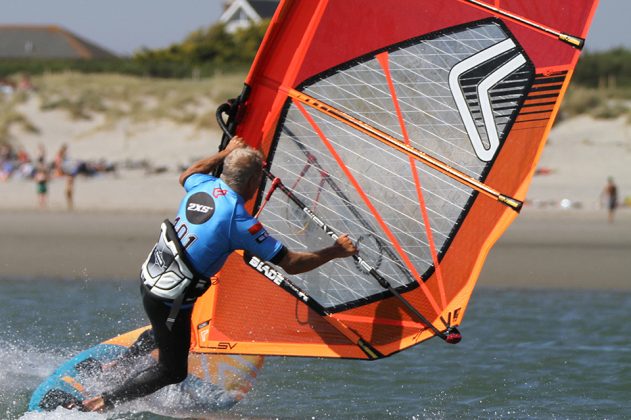Words Peter Hart // Photos Simon Bassett, Nick McCarthy, Graham White, Hart Photography and John Carter / pwaworldtour.com
Originally published within the September ’18 edition.
Like the golf swing, it looks so simple when done well. And yet the humble carve gybe continues to frustrate generations of Windies. Peter Hart describes how relatively simple changes of habit, like adjusting your stance height, can prod you to the next level, especially in chop.
I’m sat in Ialyssos in the north of Rhodes. My friend Dave White, who used to run dealer meetings out here, described it as ‘Clacton on steroids.’ He wasn’t being rude. He loves Clacton. What he meant was, that at both you launch from a pebbly foreshore into a side-shore wind from the left and onto a ‘bump and jump’ heaven … or ‘chop maelstrom’ depending on your point of view. But it’s good chop, if there is such a thing, a bit confused by the shore but when blown along by a consistent breeze, forms into rolling swell further out to sea.
The ‘steroid’ bit is that in Rhodes the sea is turquoise (not Thames Estuary beige); shorts and a rashie are slightly too warm and there’s a beach bar 20 metres from the launch spot selling beer in frozen glasses for €2.
On day one, one of my group reveals a refreshing attitude. He’d spent a good chunk of the winter on the silky smooth waters of Lac Bay in Bonaire where, he said, he could do everything. “I get here and I find out I can do nothing … it’s brilliant!” Brilliant in that he was happy to have his flaws exposed. “On Lac Bay I was planing out of most of my gybes – I haven’t done one here yet. There’s always another level!”
Well spotted sir.
THE FLAT WATER GYBE – A MOVE UNTO ITSELF
Next week I will be on holiday in Vassiliki. My favourite pastime is to wait until evening when the wind is solid and the water empty, tack up to the cliff and then scream to the inside and drop into a gybe at 100 mph by the Cosmos Hotel. It’s a dream. It’s so flat that you can take up crazy angles, bury the rail and emit fountains of spray. You have so much momentum that you can glide forever and even pause to wave to the crowd as the rig flips. But don’t kid yourself. You can’t do it anywhere else. It’s the skier’s 6 inches of powder snow on a firm base. The flat water gybe is just that – a flat water gybe. Once it chops up, you have to rethink every element of the turn.
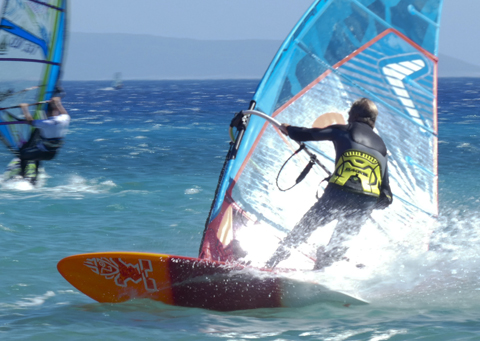
Harty horizontal on the flat waters of Vass.

SAIL BY FEEL NOT NUMBERS
Learning a move, whether it be the tennis forehand or the carve gybe, it makes perfect sense to select an arena that gives you the best chance of early success. For gybing that is of course, flat water. With success comes a joyously warm feeling and you get an immediate sense of the ‘whole’ – that is to say the length and tempo of the move and how the different stages, the set-up, carve, transition and exit, all link and flow together.
Thanks to the lack of annoying variables (chop) on flat water, your mind is free, your speed is good, the rig is light and the board glides uninterrupted on its edge despite careless feet.
You can effectively gybe by numbers.
1. Back hand down. 2. Unhook and drop down. 3. Back foot on rail and push. 4. Change feet and rig. 5. Look where you’re going.
There’s no pressing need to experiment with the sequence and build a repertoire of gybes, which is essential if you’re to take your carving into the bumps and hollows of the real world. What I’m watching from this beach in Rhodes is a lot of sailors gybing by numbers. Many are pretty good, but they only have one gybe which they roll out on every run no matter what’s in front of them. It’s a monkey and typewriters scenario. If they keep plugging away, eventually the sea opens up for them and their one technique works – but it’s not something they have any control of. Taking that numbered sequence above, every element can be tweaked to produce a different result.
1. Back hand down – but how far? The further back it goes the harder you can sheet in, the more the mastfoot pressure depresses the edge and the tighter the turn. Also the more you can oversheet which has positive and negative outcomes.
2. Unhook and sink – but how low? Adjusting your stance height effects how much pressure you have on the board at different stages of the turn.
3. Back foot on rail and press – but where on rail and how hard and for how long do you press? Foot position on the rail and the amount of pressure determine the carving angle, whether you go for a nose up or nose down gybe and the shape of the arc.
4. Change feet and rig – but when and in which order? An early foot change tends to suit a wide planing gybe, later for a slashing gybe.
5. Look where you’re going – but where is where? Around the mast or past the clew? Just the act of turning the head to look back can move the weight from front to back foot and change the pressure on the edge. So when you turn the head is critical.
“ The trick to consistently good gybing is to never always do anything…”
It’s a massive subject and one to which I will return to in the next issue. But for now I’m going to focus on a few ways to break the routine and instil a different approach to the challenge. I mention chop a lot because our ultimate aim is to apply the right amount of pressure on the edge at all stages. And to do that over chop brings certain skills sharply into focus. However the lessons learned apply to all wind and sea states.
START HIGH FOR SPONTANEITY
It’s always good to flex a little when you unhook to help you settle the board, but even in the craziest seas, you don’t have to squat. If you’re comfortable, your stance should hardly change when you unhook. By tightening the core and staying tall with the hips high and inboard, you are in far better shape to drop to the inside
and make spontaneous changes of direction.
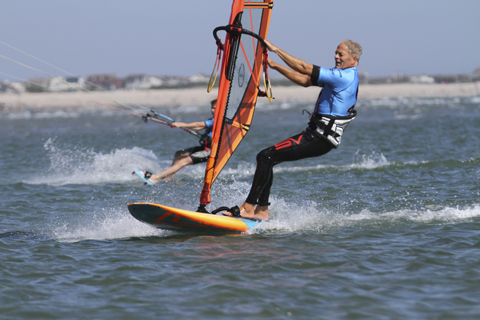
Happily powered and unthreatened, you can enter the gybe standing relatively tall. PHOTO Simon Bassett
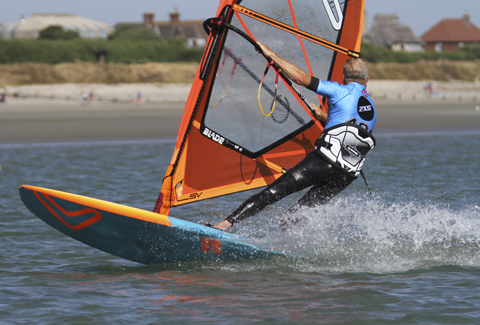
It’s then by dropping suddenly that you can really power up the rail to make, in this case, a super tight radius turn. PHOTO Simon Bassett
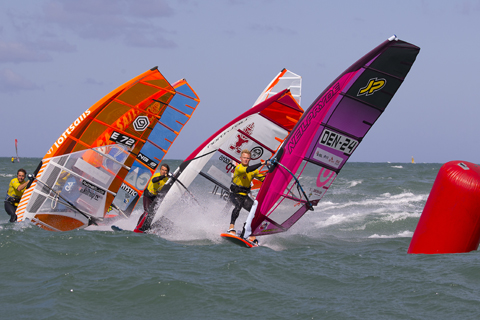
When the water is this crazy, that’s the time to get lower on entry. Their knees are bent but they’re not hanging beneath the boom with butts in the water.
PHOTO John Carter / pwaworldtour.com
SAILING AND GYBING – MORE IN COMMON THAN YOU THINK
You’re hammering towards the shore across the chop fully powered looking absolutely the player in form … until you set-up to gybe, at which point you turn into a marionette which has just had its strings cut. You go floppy, lean back and the board bounces to a halt. Why? You’re treating the gybe as something both alien and threatening. It isn’t. Think about gybing using the same fundamental trimming techniques and attitude as you do when blasting.
What allows you to sail in control at speed is keeping a constant flow of power into board though nose and tail. You stay in contact with the mastfoot by either staying sheeted in or easing the hips forward so you can lean your weight through the boom. You avoid reactive, panicky movements of body and rig by reading the water ahead. If the chop is gentle you trust the rocker line and let it ride. If it’s steeper you maintain board to water contact by softening the knees and sucking up the bumps. If you get a little air, you try to avoid a shock load on the fin by compressing on landing. All that applies to gybing. What is different is your posture and position on the board.
FROM SPEEDSTER TO SLATER (KELLY) – FROM BLASTER TO CARVER
Mike was having a dreamy time sailing smooth waves in idyllic side-off winds. I was reluctant to piss on his parade, but nevertheless had to point out that he was not so much riding them as ‘hooning’ along them – upright, resisting the power in a broad reaching speed stance. His carving consisted of rocking the whole body gently from side to side to perform the shallowest ‘wiggle’ turns. He even stayed hooked in.
Your posture must compliment what you’re doing. Blasting you’re a rock – a sensitive rock mind you, able to micro adjust, but a rock nevertheless. When you’re turning, you’re Spiderman, bendy and mobile in every direction.
Imagine an iconic windsurfer, surfer, SUP surfer or snowboarder in mid carve. They are compressed over a wide stance like a cat ready to pounce; positioned so they can dominate the board and move pressure easily from foot to foot. Their hips and upper body are tripping over their feet anticipating the change of direction. And, of course, their head projects towards the exit.
As soon as you set-up to gybe, flick the switch from ‘rock’ to Spiderman, who, by the way, is always moving.
LOW OR HIGH ON EXIT
In a hero planing gybe, the accepted method is to start high, sink all the way round and finish low in the best position to resist the power as you sheet in. Lowering your position all the way round (and dropping to the inside) also helps you power the heels as you change the feet, which tightens the exit and gets you through the downwind ‘slow down’ zone. But not every gybe describes such a glorious arc. For example, standing up after the foot change unweights the edge and allows the board to cork to the surface after an underpowered or tight radius gybe.
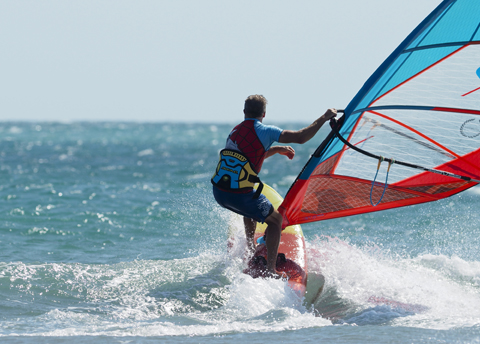
Exiting a turn through big chop or breaking waves, stay low and soften the knees to keep board to water contact. PHOTO Hart Photography
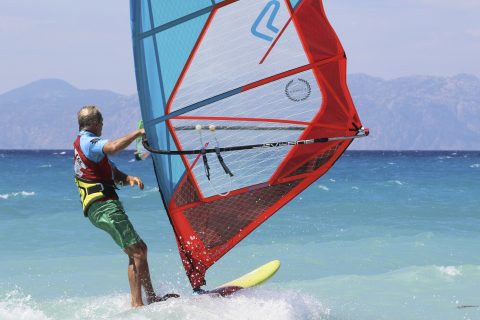
But following a tight turn, you can stand tall to allow the heel edge to rise and the board to flatten off and accelerate. PHOTO Graham White
THE UPS AND DOWNS OF GYBING
Are you aware of the height of your stance when you’re gybing? Do you start low and finish high; start high and finish low; stay the same height; or are you up and down like a jack rabbit? There’s no right answer (although there are a few wrong ones) but understand that lifting and lowering your position is key to manipulating and controlling the turn.
Let’s start by challenging some accepted wisdom.
Unhook and sink right down? If you lower your centre of gravity, you make yourself a harder object to knock over. And with bent knees you can bend and stretch legs to keep board to water contact – and that’s essential coming into a fast choppy gybe when you need to get the board settled. You’re waiting for a ‘but’ and here it comes. But many go to silly extremes, hang way off the rig to windward and drag their butts in the water, which causes two issues.
• firstly they have to haul themselves upright and inboard before they can even think about committing to the inside of the turn – a feat they often achieve by bending the arms.
• and secondly, when they’re performing a full knee bend, their only option is to stand up. Avoid the extremes of rigid and flexed. Whatever you’re doing, you should have the scope to bend and flex.
The other reason given for hanging off the boom is that it’s supposedly easier to keep the sail sheeted in when unhooked. Actually it isn’t. You’re the same weight standing tall or crouched so will have the same force on your arms.
The best hardly change their stance as they unhook. Instead of dropping the hips down, they tighten their stomach and pull down on straight arms. Yes it’s a little more tiring but you only have to do it for a couple of seconds.
The rule for me on entry is to only sink as much as you need to. If you don’t feel threatened, stay high. With a taller stance and hips high on entry, it’s easier to stay on your toes and trim the board level; and you’re nearer the centre line and in the best shape to drop into the turn. And dropping is what you have to do to carve effectively.
IN CONSTANT MOTION – DON’T BE FROZEN!
The gybe involves turning 180° in less than 5 seconds. So unless you’re constantly adjusting your sail’s sheeting angle you will instantly be under or over-sheeted. It’s the same deal with your body. Many drop into a decent Slater-esque posture as they start – but then that’s it, they’re a piece of still life.
A classic planing gybe follows the ‘in wide, out tight’ racing line. You ease in on a broad line for speed. You then steepen the carve to crack through the dreaded broad reach to broad reach ‘slow down zone’ to end up on your fastest point of sailing, just off the wind, as quickly as possible. But to be able to tighten the curve, you have to keep lowering you’re position down and to the inside of the turn. If you don’t, you’ll follow the same wide circle and stop downwind.
And perhaps now is a good moment to mention bent knees. A lot of people do it (good) because they’ve been told to … but they’re not sure why. It’s a passive action. But the aim of bending them is to give yourself the room to extend the leg(s). You’re not just sitting on the edge, you’re actively driving it into the water. You can’t do that with straight legs. If your carve starts well and then you get that dreaded kick half way round where the rail seems to fight back, it’s because a straight leg prevents you from holding it down.
I had a memorable coaching moment with a long time gyber who’d never really exited planing due to being a bit passive/defensive/floppy at the end. We were connected by headsets and I told him to compress really deep as he gybed and then on the command of ‘push’ to extend his back leg. You should have seen his little face. At the point downwind, where things normally wobbled to a stop, the board whipped around the last 30° in a nano second. He planed out so fast that his only option was to jump off. Before you all believe that stamping on the tail is the sure fire route to glory, let me add that it only works if you’re leaning forward in front of your feet and driving the tail out behind you.
UP AND DOWN? SURELY NOT
Everyone is looking for the guaranteed weight loss program and I have it. It’s to spring up or sink down. It works every time – but sadly for only about half a second. Standing on a scales, if you fold your legs or spring up, for a moment the needle points to 0kg. But then sadly, straight after the extension or collapse, follows a moment of extreme ‘weighting’ where you literally double in size. The best can exploit this sudden weight loss and gain in their gybing. The best time to move the feet is when you’re momentarily weightless. The best moment to drive the rail is when you’re momentarily weighted.
THE DRIVE AND RELEASE
In an interesting and confusing way, golden rules appear to turn on their head as you progress. You’re instructed when learning to plane, to pretend you’re treading on eggshells. Keep body, rig and board still and calm and let the board be driven along at a constant angle by a steady flow of power. Then suddenly we introduce pumping and bumping. Pumping is about dropping the hips to drive the board into the water with a shock load and then lifting the hips and standing tall to release it, whereupon, in a perfect world, it corks up and overtakes its bow wake. From then on this drive and release action comes into a host of moves, including jumping, wave riding and gybing.
THE NAISH SLAM
Back in the 90s in conjunction with this very publication, I made a video called ‘Carve Clinic 2.’ It contained about 103 sequences of me gybing, but the one most remember was of a certain Robby Naish cracking one in Fuerteventura. He approached the beach sheeted out, barely planing, looking as if was coming in for a rest; but then in a heartbeat, slashed it round on the tail in a super tight circle AND planed out. How was that even possible?
It was all down to drive and release. He’d momentarily drive the rail and tail by dropping low and sheeting in hard but then instantly release it by standing tall, stepping forward and releasing the rig. It was the tail corking to the surface which pushed him out on the plane. In terms of height, he went tall, low, tall again, all within 3 seconds. It’s a technique which is now ever more effective thanks to wider, more voluminous rails and tails. And that leads us ever so neatly onto the subject of handling this choppy stuff.
CHOP – WHAT IS GOING ON?
There are 1000 reasons why choppy gybing is harder, but top of the list are:
• you are mentally defensive which in turn makes you physically defensive and prone to taking up back seat positions.
• you’re going slower (flat is faster, end of …). You have less residual speed and so the board stalls sooner. The rig is more powered and apt to pull you off balance.
• A rail bogs and trips when it sinks too deep (how deep it can go depends on the design; much deeper on wave boards). Pressing it into chop with heavy feet is the best way to over-sink it.
• You sheet in at the wrong moment, for example as you bank into a piece of chop. The mastfoot pressure drives the rail in up to the nose and (once again depending on the design) over you go.
That last one is what confounds so many.
SLALOM THE ULTIMATE CONTROL TEST
The recent PWA slalom event in S. Korea was generally accepted as one of the most technically challenging ever in the history of the PWA. It was windy, nothing new there for the top guns. However the sea state was ‘off the clock’ confused. Lightening fast slalom boards, powered to the maximum and beyond on water littered with random lumps and wedges – there is no greater test of slalom skill. Success comes from reading the water, taking up the most stable position on the board and knowing exactly when to power the sail and rail. You could spend years trying to get the pic below (well done JC!) which shows the three sailors at slightly different states of the arc, all with different challenges and options.
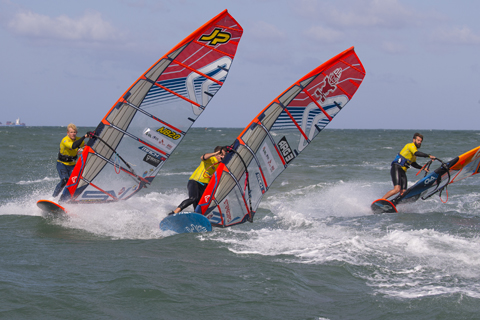
Amado Vrieswijk has his sail open, controlling the board by compressing and projecting forward and leaning forward on the front hand to hold the nose down – the rig dropped slightly to leeward to give him a view of the water ahead. He’s waiting, hoping to find a moment to sheet in. Coming off a crest onto a flat(ish) downslope, the prospects are good.
Gonzalo Costa Hoevel is really going for it. The water state ahead for him looks grim. Not only is he banking into steep chop, but he has sailor wake to contend with too, and all the spin out joy that can bring. Sensibly he decides not to sheet in violently and lay the rig down, which could cause the rail to bog and die. Instead he holds it open and drives his weight forward through the boom to control the nose. The danger now with the sail open is the clew smacking a bit of chop.
Ross Williams, though a little luck and a lot of judgement, finds himself in as good a shape as it’s possible to be in such conditions. He’s found that momentary flat slope which has allowed him to sheet in and crank both board and sail over. He might as well be sailing on the mirror flat waters of Portland Harbour in a force 4! Being oversheeted and compressed into the perfect surfing stance, he has control of every inch of the rail. And what happened next? I have absolutely NO idea!
HOW AND WHEN TO SHEET IN
I learned most about gybing during my years doing slalom. On photo shoots it was a blast. Needing to look good, we found flat water. We would scream in and with the apparent wind on our noses and the rig as light as a feather, sheet it in, lay it down, smile, glide for a hundred metres before picking it up and flipping it as if handling a day old chick.
In the heat of battle it was never like that. You’d be flying into the mark over swell, wind waves and sailor chop, unhooked, the sail tugging your arms out, your back hand almost touching the clew. Preparing to carve, you’d be looking around the mast, hoping and praying for a small downslope, a tiny flat patch where you could oversheet, lay the rail and accelerate around. If there wasn’t one you’d have to lean the rig forward and open, ease gently onto the rail, carve a long arc and try and hold the rail at a steady angle with super soft knees. It certainly never made the brochure. Check the slalom pics – not even the good guys can oversheet and lay it down when it’s choppy.
Free sailing, you’re not going as fast nor are you hanging on to as much sail – and you may well be on a board which turns more readily. However, the idea is the same.
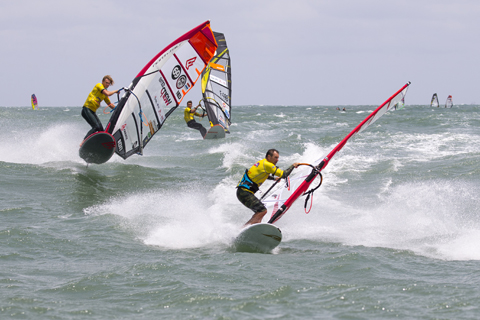
Compared to Josh Angulo in front, the prospects don’t look great for Jordy Vonk as he enters a gybe. But when you get a bit of involuntary air blasting in a straight line, you don’t panic – you just compress on landing to soften the shock. Do the same gybing and it’s amazing what you can recover from.
PHOTO John Carter / pwaworldtour.com
You’re looking for the hint of a downslope or a flat patch where you can commit to both rig and rail and tighten the turn up before you run up the back of the next one. And tightening the turns and going deeper in the subject of varying the turn radius is the subject of the next issue. I’ll also be looking at your rig and foot transition techniques and seeing how board design limits and enhances your gybing options.
More supreme windsurfing knowledge from Harty next issue, but if you fancy meeting the master in person then why not join him on one of his famous clinics. They book up well in advance these days, but get in early by checking out www.peter-hart.com


